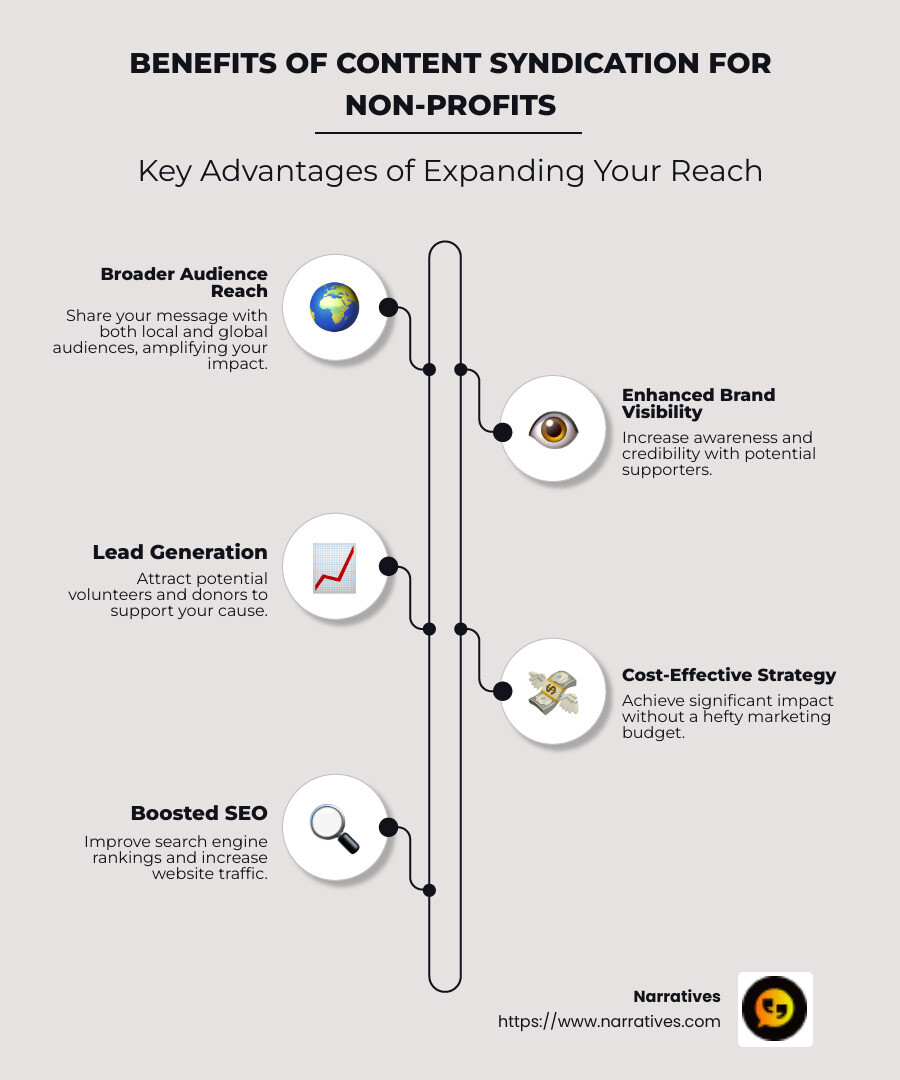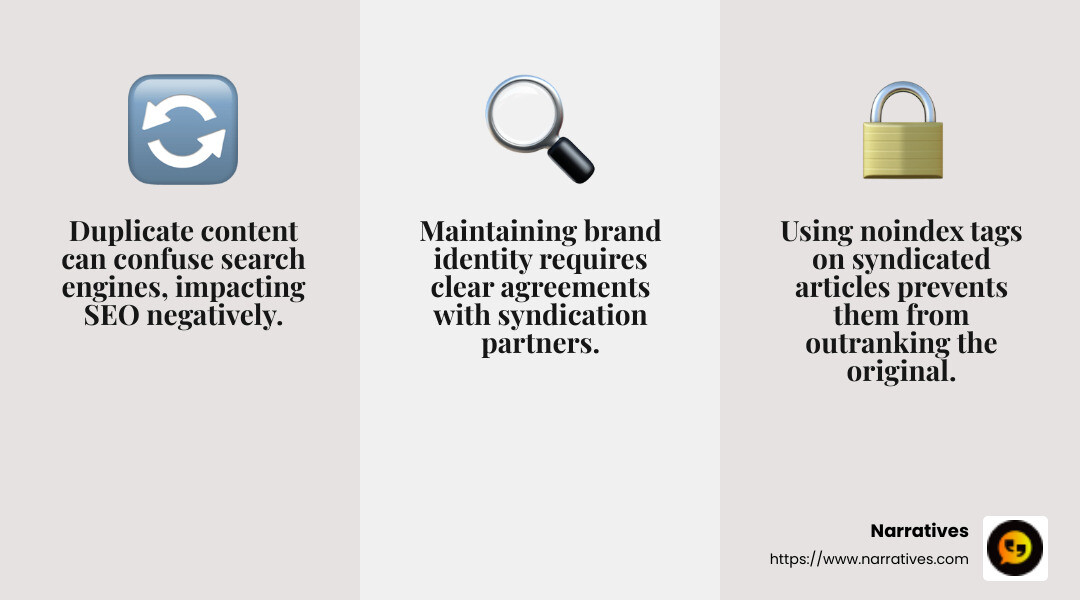The Hidden Benefits of Content Syndication You Need to Know

Open uping the Power of Content Syndication for Non-Profits
Benefits of content syndication are crucial for non-profits looking to amplify their message through digital storytelling. By sharing your content across various platforms, non-profits can significantly boost their reach, visibility, and engagement—all essential for driving social change and advocacy.
Here's why content syndication is a game-changer for non-profits:
- Broader Audience Reach: Share your message with both local and global audiences.
- Improved Brand Visibility: Increase awareness and credibility with potential supporters.
- Lead Generation: Attract potential volunteers and donors to support your cause.
- Cost-Effective Strategy: Achieve these benefits without a hefty marketing budget.
- Boosted SEO: Improve search engine rankings and increase website traffic.
For non-profits, content syndication isn't just an option—it's a strategic necessity. It helps you tell your story to the world, engage with your community, and inspire action. As a non-profit leader facing limited resources, you need a partner like Narratives to help make your story heard.

Understanding Content Syndication
Content syndication is a powerful tool that allows you to republish your digital content across various third-party platforms. This strategy is key for expanding your audience reach and increasing your brand's visibility.
What is Content Syndication?
Simply put, content syndication involves taking your existing content—like articles, videos, or infographics—and sharing it on other websites. These third-party platforms may include industry blogs, news sites, and dedicated content syndication networks. By doing so, you tap into their established audiences, which can be much larger than your own.
How Does It Work?
The process is straightforward:
- Select Content: Choose high-quality, valuable content that resonates with your audience.
- Find Platforms: Identify third-party sites that align with your brand and message.
- Negotiate Terms: Agree on how your content will be used, credited, and linked back to you.
- Monitor Performance: Track how your syndicated content performs and adjust your strategy as needed.
Benefits of Content Syndication
Broader Reach: By leveraging third-party platforms, you can reach audiences you might not have access to otherwise. This is especially beneficial for non-profits looking to share their message widely.
Increased Brand Visibility: Getting your content in front of new eyes can improve your brand's presence and credibility.
Lead Generation: As your content reaches more people, you have a better chance of attracting potential supporters or customers.
Why Use Content Syndication?
For organizations like non-profits, content syndication offers a cost-effective way to amplify their message without the need for a large marketing budget. By partnering with platforms that align with their mission, they can tell their story to a broader audience and inspire action.

In summary, content syndication is a strategic approach to expanding your content's reach and visibility. By republishing your content on third-party platforms, you can effectively engage with larger audiences and drive meaningful interactions with your brand.
The Benefits of Content Syndication
Increased Reach and Visibility
One of the most significant benefits of content syndication is its ability to dramatically increase your reach and visibility. By sharing your content across multiple platforms, you can connect with global audiences who may not have finded your brand otherwise. This expanded reach helps boost brand awareness, putting your message in front of new eyes.
For instance, when a company like Reach PLC syndicates a story, it can get coverage across numerous regional outlets, amassing over 126 links, as seen in their media blitz across the UK. This kind of exposure is invaluable for building a broader audience base.
Improved SEO and Backlink Profile
Content syndication can also improve your search engine rankings. When your content is featured on authoritative sites, it often includes backlinks to your original work. These links are like votes of confidence from other websites, bolstering your site's domain authority.
Consider this: Google views both linked and unlinked brand mentions as "implied" links, which can still support your SEO efforts. As Google’s Gary Illyes suggests, if your content is cited widely, you’re on the right track.
Cost-Effective Content Distribution
For many, the appeal of content syndication lies in its resource efficiency. Instead of constantly creating new content, you can repurpose existing assets, making it a budget-friendly option. This is particularly advantageous for non-profits or smaller organizations with limited marketing funds.
Free channels like LinkedIn or Medium allow you to distribute your content without extra costs, while paid options offer more targeted reach. By selecting the right partners, you can ensure your content reaches the most relevant audiences, maximizing your investment.
Content syndication is a strategic way to improve your brand's online presence, attract leads, and improve your SEO—all while keeping costs in check.
Challenges and Considerations
While content syndication offers many benefits, it's not without its challenges. Two key issues are duplicate content and maintaining a strong brand identity. Let's explore how to tackle these effectively.
Mitigating Duplicate Content Issues
One major concern with content syndication is the risk of duplicate content. When your content appears on multiple sites, search engines like Google might see it as redundancy, which can hurt your rankings. However, there are ways to mitigate this.
First, ensure that syndicated content includes proper attribution to the original source. This can be achieved by adding metadata that indicates the parent website. This practice helps search engines recognize that the content is syndicated rather than copied.
Additionally, while the canonical link element was once a common tool to address duplication, Google has shifted its advice. As of early 2023, Google recommends using the noindex meta tag on syndicated articles. This tells search engines not to index these versions, preventing them from outranking the original.
Maintaining Brand Identity
Another challenge is maintaining a consistent brand identity. When your content is spread across various platforms, you risk losing control over how it's presented. This can dilute your brand message and confuse your audience.
To maintain control, it's crucial to establish clear agreements with your syndication partners. These agreements should specify that no changes can be made to your content without permission. Regular monitoring is also essential to ensure your content aligns with your brand values.
Moreover, select partners who share your brand's ethos. This alignment ensures that your content is presented in a way that resonates with your intended audience.
By addressing these challenges head-on, you can harness the power of content syndication while safeguarding your brand's integrity and search engine performance.

Now, let's move on to understanding the frequently asked questions about content syndication.
Frequently Asked Questions about Content Syndication
What is content syndication?
Content syndication is the practice of republishing your content on third-party platforms to reach a broader audience. Think of it as giving your content a second life. Instead of staying confined to your own website, your articles, videos, or infographics can appear on other reputable sites. This helps you tap into new audiences who might not have finded your content otherwise.
Imagine sharing a great story with a friend, who then shares it with their friends. That’s syndication in a nutshell. It allows your content to travel beyond its original home, amplifying your message and increasing your brand's visibility.
How does content syndication impact SEO?
When done right, content syndication can have a positive impact on SEO. By placing your content on high-authority sites, you can gain valuable backlinks. These links act like votes of confidence, improving your domain authority and search engine rankings.
However, you need to be cautious about duplicate content issues. As mentioned, using the noindex meta tag on syndicated articles can help prevent search engines from ranking duplicates higher than your original content. This ensures that your site remains the primary source in search engine results.
Can content syndication generate leads?
Yes, content syndication can be a powerful tool for lead generation. By reaching audiences on trusted third-party platforms, you can attract potential customers who are already engaged with similar content.
According to research, 82% of marketers use content syndication specifically for lead generation. When your content resonates with a reader, they're more likely to follow your links back to your website. Here, they can engage further, perhaps by signing up for newsletters or downloading resources, effectively opting into a relationship with your brand.
Content syndication not only extends your reach but also brings qualified leads to your doorstep.
Conclusion
At Narratives, we understand the power of storytelling in creating meaningful social impact. Our mission is to lift underrepresented voices by partnering with non-profits and purpose-driven organizations. Through content syndication, we help these organizations amplify their stories, reaching wider audiences and driving real change.
Storytelling is at the heart of everything we do. It’s not just about sharing information; it's about connecting emotionally with people. When done effectively, storytelling can inspire action, build trust, and increase visibility for important causes. By distributing content across multiple platforms, we ensure that these stories reach those who can benefit from them most.
The social impact of effective content syndication cannot be overstated. As stories spread, they raise awareness about critical issues, mobilize communities, and inspire support for non-profits. This ripple effect can lead to increased donations, volunteer engagement, and policy changes that improve lives.
We invite you to learn more about how Narratives can help your organization harness the benefits of content syndication to create lasting social impact. Explore our services and let us help you share your story with the world.


